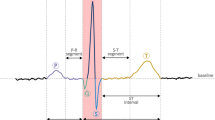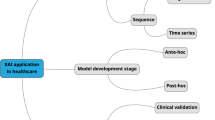Abstract
The assessment of signal quality has been a research topic since the late 1970s, as it is mainly related to the problem of false alarms in bedside monitors in the intensive care unit (ICU), the incidence of which can be as high as 90 %, leading to alarm fatigue and a drop in the overall level of nurses and clinicians attention. The development of efficient algorithms for the quality control of long diagnostic electrocardiographic (ECG) recordings, both single- and multi-lead, and of the arterial blood pressure (ABP) signal is therefore essential for the enhancement of care quality. The ECG signal is often corrupted by noise, which can be within the frequency band of interest and can manifest similar morphologies as the ECG itself. Similarly to ECG, also the ABP signal is often corrupted by non-Gaussian, nonlinear and non-stationary noise and artifacts, especially in ICU recordings. Moreover, the reliability of several important parameters derived from ABP such as systolic blood pressure or pulse pressure is strongly affected by the quality of the ABP waveform. In this work, several up-to-date algorithms for the quality scoring of a single- or multi-lead ECG recording, based on time-domain approaches, frequency-domain approaches or a combination of the two will be reviewed, as well as methods for the quality assessment of ABP. Additionally, algorithms exploiting the relationship between ECG and pulsatile signals, such as ABP and photoplethysmographic recordings, for the reduction in the false alarm rate will be presented. Finally, some considerations will be drawn taking into account the large heterogeneity of clinical settings, applications and goals that the reviewed algorithms have to deal with.



Similar content being viewed by others
References
Aboukhalil A, Nielsen L, Saeed M, Mark RG, Clifford GD (2008) Reducing false alarm rates for critical arrhythmias using the arterial blood pressure waveform. J Biomed Inform 41:442–451. doi:10.1016/j.jbi.2008.03.003.Reducing
Ali W, Eshelman L, Saeed M (2004) Identifying artifacts in arterial blood pressure using morphogram variability. Comput Cardiol 31:697–700
Allen J, Murray A (1996) Assessing ECG signal quality on a coronary care unit. Physiol Meas 17:249–258
Asgari S, Bergsneider M, Hu X (2010) A robust approach toward recognizing valid arterial-blood-pressure pulses. IEEE Trans Inf Technol Biomed 14:166–172. doi:10.1109/TITB.2009.2034845
Behar J, Oster J, Li Q, Clifford GD (2012) A single channel ECG quality metric. Comput Cardiol 39:381–384
Behar J, Oster J, Li Q, Clifford GD (2013) ECG signal quality during arrhythmia and its application to false alarm reduction. IEEE Trans Biomed Eng 60:1660–1666
Chambrin MC (2001) Alarms in the intensive care unit: how can the number of false alarms be reduced? Crit Care 5:184–188
Chen Y, Yang H (2012) Self-organized neural network for the quality control of 12-lead ECG signals. Physiol Meas 33:1399–1418. doi:10.1088/0967-3334/33/9/1399
Chudacek V, Zach L, Kuzilek J, Spilka J, Lhotska L (2011) Simple scoring system for ECG quality assessment on Android platform. Comput Cardiol 38:449–451
Clifford GD (2006) ECG statistics, noise, artifacts, and missing data. In: Clifford GD, Azuaje F, McSharry PE (eds) Advanced methods and tools for ECG data analysis. Artech House, pp 55–99
Clifford GD, Long WJ, Moody GB, Szolovits P (2009) Robust parameter extraction for decision support using multimodal intensive care data. Philos Trans A Math Phys Eng Sci 367:411–429. doi:10.1098/rsta.2008.0157
Clifford GD, Lopez D, Li Q, Rezek I (2011) Signal quality indices and data fusion for determining acceptability of electrocardiograms collected in noisy ambulatory environments. Comput Cardiol 38:285–288
Clifford GD, Behar J, Li Q, Rezek I (2012) Signal quality indices and data fusion for determining clinical acceptability of electrocardiograms. Physiol Meas 33:1419–1433. doi:10.1088/0967-3334/33/9/1419
Devlin PH, Mark RG, Ketchum JW (1984) Detecting electrode motion noise in ECG signals by monitoring electrode impedance. Comput Cardiol 11:227–230
Di Marco LY, Duan W, Bojarnejad M, Zheng D, King S, Murray A, Langley P (2012) Evaluation of an algorithm based on single-condition decision rules for binary classification of 12-lead ambulatory ECG recording quality. Physiol Meas 33:1435–1448. doi:10.1088/0967-3334/33/9/1435
Feldman CL, Hubelbank M, Haffajee CI, Kotilainen P (1979) A new electrode system for automated ECG monitoring. In: Proceedings in computers in cardiology
Ferguson PF Jr, Mark RG, Burns SK (1986) An algorithm to reduce false positive alarms in arrhythmia detectors using dynamic electrode impedance monitoring. In: Proceedings of computers in cardiology
Hamilton PS, Tompkins WJ (1986) Quantitative Investigation of QRS detection rules Using the MIT/BIH arrhythmia database. IEEE Trans Biomed Eng BME-33:1157–1165
Hayn D, Jammerbund B, Schreier G (2011) ECG quality assessment for patient empowerment in mHealth applications. Comput Cardiol 38:353–356
Hayn D, Jammerbund B, Schreier G (2012) QRS detection based ECG quality assessment. Physiol Meas 33:1449–1461. doi:10.1088/0967-3334/33/9/1449
Jekova I, Krasteva V, Christov I, Abächerli R (2012) Threshold-based system for noise detection in multilead ECG recordings. Physiol Meas 33:1463–1477. doi:10.1088/0967-3334/33/9/1463
Johannesen L (2011) Assessment of ECG quality on an Android platform. Comput Cardiol 38:433–436
Johannesen L, Galeotti L (2012) Automatic ECG quality scoring methodology: mimicking human annotators. Physiol Meas 33:1479–1489. doi:10.1088/0967-3334/33/9/1479
Johnson AE, Behar J, Andreotti F, Clifford GD, Oster J (2015) Multimodal heart beat detection using signal quality indices. Physiol Meas 36(8):1665
Kalkstein N, Kinar Y, Naõaman M, Neumark N, Akiva P (2011) Using machine learning to detect problems in ECG data collection. Comput Cardiol 38:437–440
Kuzilek J, Huptych M, Chudacek V, Spilka J, Lhotska L (2011) Data driven approach to ECG signal quality assessment using multistep SVM classification. Comput Cardiol 38:453–455
Lawless ST (1994) Crying wolf: false alarm in a pediatric intensive care unit. Crit Care Med 22:981–985
Li Q, Clifford GD (2012) Signal quality and data fusion for false alarm reduction in the intensive care unit. J Electrocardiol 45:596–603. doi:10.1016/j.jelectrocard.2012.07.015
Li Q, Mark RG, Clifford GD (2008) Robust heart rate estimation from multiple asynchronous noisy sources using signal quality indices and a Kalman filter. Physiol Meas 29:15–32
Li Q, Mark RG, Clifford GD (2009) Artificial arterial blood pressure artifact models and an evaluation of a robust blood pressure and heart rate estimator. Biomed Eng Online 8:13. doi:10.1186/1475-925X-8-13
Liu C, Li P, Zhao L, Liu F, Wang R (2011) Real-time signal quality assessment for ECGs collected using mobile phones. Comput Cardiol 38:357–360
McNames J, Thong T, Aboy M (2004) Impulse rejection filter for artifact removal in spectral analysis of biomedical signals. Conf Proc IEEE Eng Med Biol Soc 1:145–148. doi:10.1109/IEMBS.2004.1403112
Moody BE (2011) Rule-based methods for ECG quality control. Comput Cardiol 38:361–363
Moody GB, Mark RG (1982) Development and evaluation of a 2-lead ecg analysis program. Computers in cardiology 9:39–44
Moody GB, Mark RG (1989) QRS morphology representation and noise estimation using the Karhunen–Loeve transform. In: Proceedings in computers in cardiology. IEEE, Jerusalem, pp 269–272
Naseri H, Homaeinezhad MR (2015) Electrocardiogram signal quality assessment using an artificially reconstructed target lead. Comput Methods Biomech Biomed Eng 8(10):1126–1141
Pimentel MA, Santos MD, Springer DB, Clifford GD (2015) Heart beat detection in multimodal physiological data using a hidden semi-Markov model and signal quality indices. Physiol Meas 36(8):1717
Schmid F, Goepfert MS, Reuter DA (2013) Patient monitoring alarms in the ICU and in the operating room. Crit Care 17:216. doi:10.1186/cc12525
Siebig S, Kuhls S, Imhoff M, Langgartner J, Reng M, Scholmerich J, Gather U, Wrede CE (2010) Collection of annotated data in a clinical validation study for alarm algorithms in intensive care—a methodologic framework. J Crit Care 25:128–135
Sun JX, Reisner AT, Mark RG (2006) A signal abnormality index for arterial blood pressure waveforms. Comput Cardiol 33:13–16
Tsien CL, Fackler JC (1997) Poor prognosis for existing monitors in the intensive care unit. Crit Care Med 25:614–619
Wang JY (2002) A new method for evaluating ECG signal quality for multi-lead arrhythmia analysis. Comput Cardiol 29:85–88
Zaunseder S, Huhle R, Malberg H (2011) CinC challenge—Assessing the usability of ECG by ensemble decision trees. Comput Cardiol 38:277–280
Zong W, Moody GB, Jiang D (2003) A robust open-source algorithm to detect dnset and duration of QRS complexes. Comput Cardiol 30:737–740
Zong W, Moody GB, Mark RG (2004) Reduction of false arterial blood pressure alarms using signal quality assessment and relationships between the electrocardiogram and arterial blood pressure. Med Biol Eng Comput 42:698–706
Acknowledgments
This research was supported by the Shockomics Grant (FP7 EU Project No 602706).
Author information
Authors and Affiliations
Corresponding author
Ethics declarations
Conflict of interest
The authors declare that there are no conflicts of interest.
Rights and permissions
About this article
Cite this article
Gambarotta, N., Aletti, F., Baselli, G. et al. A review of methods for the signal quality assessment to improve reliability of heart rate and blood pressures derived parameters. Med Biol Eng Comput 54, 1025–1035 (2016). https://doi.org/10.1007/s11517-016-1453-5
Received:
Accepted:
Published:
Issue Date:
DOI: https://doi.org/10.1007/s11517-016-1453-5




